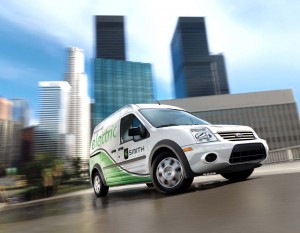
Ford hopes to launch its first commercial battery-electric vehicle, the Transit Connect EV, in 2010, with a battery-powered Focus to follow a year later.
Battery-powered vehicles, whether hybrids, plug-ins or pure battery-electric vehicles, “are the future,” says Ford Motor Co. CEO Alan Mulally. But while the automaker has committed to bring all three forms of battery vehicles to market in the next few years, Ford officials warn that it will take significant reductions in cost to move such technology into the mainstream.
With the recent launch of the Ford Fusion and Mercury Milan, the second generation of the company’s hybrid-electric vehicles, Ford has been able to cut costs for the underlying hybrid technology by 30%, and the automaker is targeting yet another 30% reduction with its Gen-3 battery technology, global product chief Derrick Kuzak tells TheDetroitBureau.com

Stay green...get you auto news online!
“We know how to make the technology work,” says Kuzak, so now we’re working on affordability.” But the soft-spoken executive quickly stresses that, “We can’t do this by ourselves.”
Ford’s efforts at “electrification” involve a number of different partnerships and licensing agreements. Though the automaker insists the basic hybrid drive in vehicles like the Fusion and Escape was developed in-house, Ford did agree to license certain technologies from Toyota.
Meanwhile, the electric drive system that will be used on pure battery-electric vehicles like the Transit Connect EV – due to market in 2010 – and the Focus EV – debuting a year later – is essentially a plug-and-play powertrain provided by the Canadian mega-supplier Magna International.
“We basically just supply them the vehicle,” explains Mark Olance, a member of the Ford EV development team.
An advantage in using the Magna system is that it can be quickly fitted to many of Ford’s new global vehicle platforms, with only a modest amount of modifications. “That’s a way to drive more volume and we have to get more volume to drive affordability,” explains Kuzak.
Both EVs will have a range of around 70 to 100 miles per charge, according to Olance, using a lithium-ion battery pack that can be fully charged in six hours on 110 volt power and roughly half that using a 220 volt charger.
The Transit Connect battery truck will be earmarked for fleet and small business customers, according to Kuzak, who calls it “a perfect match (for those) driving a prescribed route every day.” The Focus, on the other hand, will target a niche consumer market, particularly, “people who live in cities and have a prescribed route for getting to work and (who) may have a second vehicle for driving longer distances on the weekend.”
Both vehicles could also prove popular in overseas markets, especially in countries like China and India, where motorists typically drive shorter distances than in the U.S.
Like other manufacturers, Ford is hoping to see battery performance improve, even as costs fall. There are signs this is happening. The second-generation nickel-metal hydride batteries in the Fusion Hybrid are significantly smaller and more powerful than the packs used in the earlier Escape Hybrid.
Other manufacturers report similar improvements and are projecting marked gains with their lithium-ion technology. In its first product, the high-performance Roadster, the Silicon Valley start-up, Tesla Motors, required nearly 7,000 laptop computer style batteries, which, in turn, made up the bulk of the cost of the $100,000 sports car. Tesla believes it will be able to deliver better range, at a lower cost, when it launches the much bigger Model S sedan, early in the coming decade.
But the in-car hardware is only part of the challenge, Ford’s Kuzak cautions. With the exception of conventional hybrids, which generate their own power, even the best battery-based vehicles will need to be charged on a regular basis.
“And that,” the Ford executive stresses, “is why we’re seeing government, utilities, suppliers and automakers all joining together to provide the energy source and make it accessible, in a safe way and a smart way, to consumers.”
Ford, like many of its competitors, has been forming alliances with various utility companies to field test its electric vehicles. And, going forward, the utility industry will be called upon to help set up a nationwide grid of charging stations.
How much demand there will be for plug-ins and battery-electrics like the Fusion EV, Kuzak declines to suggest, admitting, “it would only be a guess. But like any other technology, it depends on volume, and there, it’s a matter of the chicken and the egg.”
To help improve volumes, Ford is following the lead set by other fledgling EV manufacturers, such as Nissan. “There’s the opportunity to create different business models,” says Kuzak, such as selling the vehicle itself then leasing the battery at an affordable monthly rate in line with what a motorist might otherwise expect to spend on gasoline.
Nissan has also raised the possibility of selling used battery packs to the utility industry to level loads provided by renewal energy sources, such as solar and wind power.
Though the electrification of the auto industry takes Ford into a brave new world, Kuzak insists, “We’re committed.” Adds Mulally, “It’s coming.” The question is when the technology and the infrastructure to support it will be ready.
